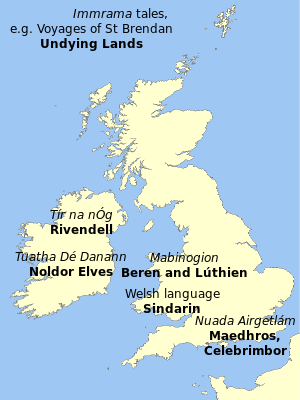
J. R. R. Tolkien derived the characters, stories, places, and languages of Middle-earth from many sources. Among these are the Celtic legends and languages, which for Tolkien were principally Irish and Welsh. He gave multiple conflicting reasons for his liking for Welsh. Tolkien stated directly that he had made use of Welsh phonology and grammar for his constructed Elvish language Sindarin. Scholars have identified multiple legends, both Irish and Welsh, as likely sources of some of Tolkien's stories and characters; thus for example the Noldorin Elves resemble the Irish Tuatha Dé Danann, while the tale of Beren and Lúthien parallels that of the Welsh Culhwch and Olwen. Tolkien chose Celtic names for the isolated settlement of Bree-land, to distinguish it from the Shire with its English names.
Tolkien denied that he had been influenced by the Celtic Arthurian legends, but scholars have likened several of his characters to Arthurian figures, including Gandalf with Merlin and Galadriel with the Lady of the Lake. Further, there are close parallels between the hero Aragorn with his magical sword Andúril and King Arthur and his sword Excalibur.
Interpreters of Tolkien's Middle-earth, including the film-maker Peter Jackson who made the 2001–2003 The Lord of the Rings film trilogy and the composer Howard Shore who created the music for the films, have chosen to portray the Elves using an otherworldly and ethereal modern conception of the Celtic, of the kind mocked by Tolkien.
- ^ Cite error: The named reference
Celticwas invoked but never defined (see the help page). - ^ Burns 2005, p. 54.
- ^ Kocher 1974.
- ^ Shippey 2005, pp. 324–328.
- ^ Burns 2005, p. 21.
- ^ Salo 2004, p. 95.
- ^ Cite error: The named reference
Fimi 2006was invoked but never defined (see the help page). - ^ Cite error: The named reference
Bowers 2019was invoked but never defined (see the help page). - ^ Shippey 2005, pp. 193–194.